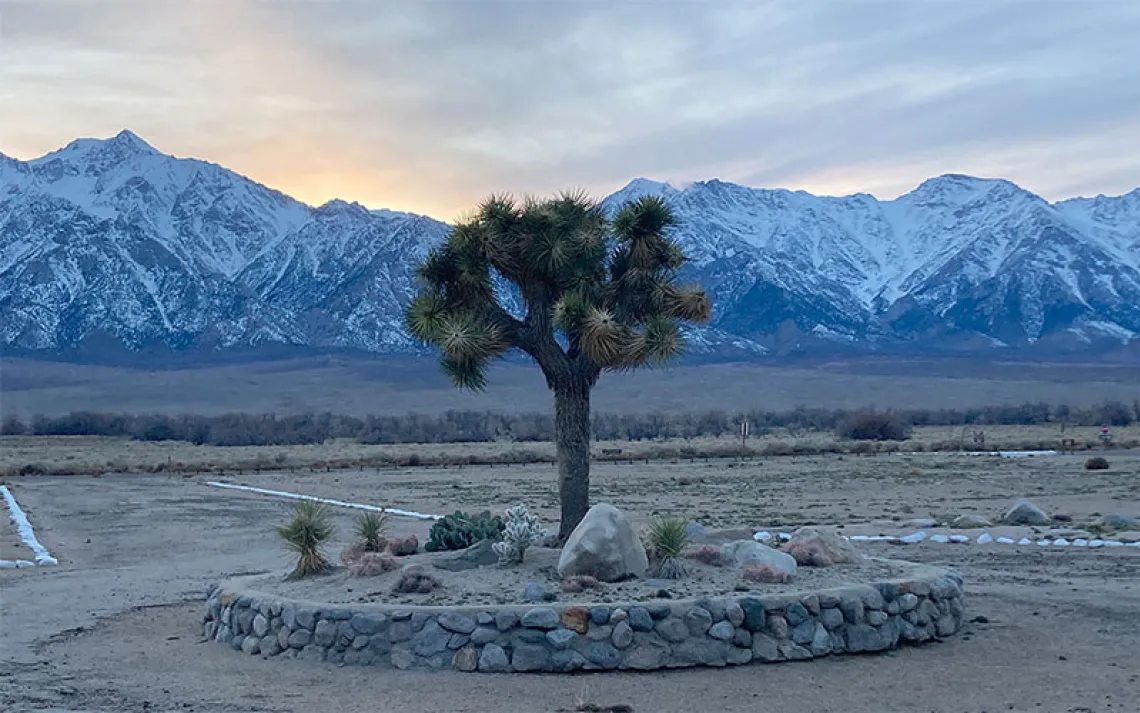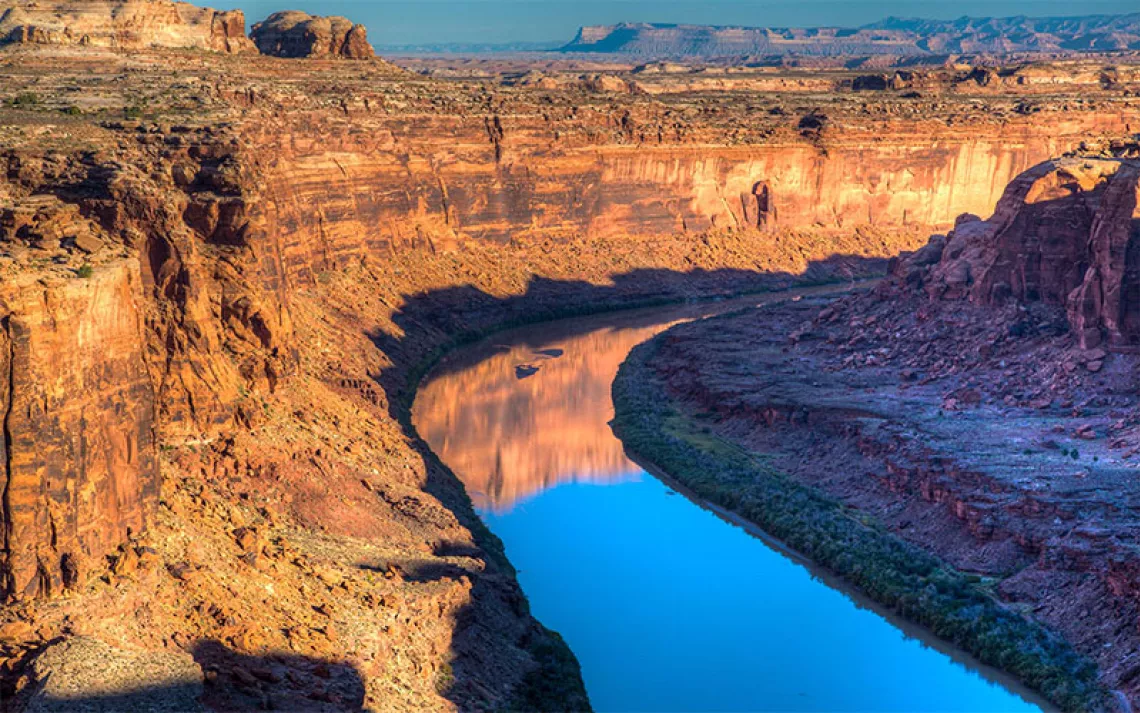Six Million Sweet Acres
From the quiet canyons of Vermilion to the lavish wildflowers of Carrizo, Americans have nearly two dozen new national monuments to explore

Grand Staircase–Escalante National Monumment, Utah | Photo courtesy Bureau of Land Management
When Bill Clinton set out to designate new national monuments starting in 1996, mining, oil, and timber companies and their allies in Congress were apoplectic. Clinton’s actions amounted to nothing less than a “lock up” of 6.1 million acres of American land, they claimed, an undemocratic federal move that trampled the will of the people. Never mind that most of the monuments were proposed for protection by nearby residents and that scores of community meetings were held to determine the wisdom of setting them aside. Never mind that Clinton was motivated to invoke the Antiquities Act of 1906—the same tool Teddy Roosevelt used in 1908 to save 800,000 acres of the Grand Canyon from prospectors and tourism promoters—because he faced an uncooperative Congress deaf to Americans’ calls for wildlands preservation. (By contrast, previous Congresses have liked monuments so much that they have reclassified 30 of them as national parks, including Arizona’s Petrified Forest, California’s Death Valley, Alaska’s Glacier Bay, and the Grand Canyon itself.)
“This is not about locking lands up,” Clinton argued while dedicating Giant Sequoia National Monument in California last year, one of 22 monuments he designated or expanded by presidential proclamation during his two terms in office. “This is about freeing lands up from the threat of development so children of the future can enjoy these places.”
Last year, then–Interior secretary Bruce Babbitt explained the Clinton administration’s push for new monuments as a way to resolve the conflicts that arise from the country’s broad policy of “multiple use” of public lands. “You can’t have a cattle ranch, a mine, a timber mill, and a campground all on the same forty acres,” Babbitt told Backpacker magazine while touring what would become Canyons of the Ancients National Monument in Colorado. “We [need to] think of public lands in terms of the dominant and preferable public use of that particular area. We’ve got to get away from this idea that every square acre is available for everything. These natural landscapes are unique, historic American treasures. They need more care and protection than we are giving them.”
Now that the Bush-Cheney oil-timber-mining juggernaut has let us know what it considers “dominant and preferable,” “locking up” public lands seems more prudent than imperious. Think of it as a way to lock out forces whose long-range vision for American lands stops at the next quarterly earnings statement. (Which is exactly how the Antiquities Act has been used since its inception: The same year the Grand Canyon was protected, Muir Woods National Monument in Northern California was set aside, a step ahead of plans to log it and submerge it under a reservoir.)
With the exception of two stunning tropical underwater ecosystems in the U.S. Virgin Islands, two 19th-century forts that once guarded New York’s harbor, and Abraham Lincoln’s summer retreat in northwest Washington, D.C., the “Clinton 22” are an archaeological and biological Grand Tour of the American West. They include 71,100-acre Agua Fria National Monument 40 miles north of sprawling Phoenix, home to 450 prehistoric sites (including four major settlements) as well as grassy mesas and formidable canyons; Pompeys Pillar near Billings, Montana, where William Clark of the Lewis and Clark expedition carved his signature and the date in sandstone during his return trip to St. Louis in 1806—the only remaining physical evidence of the Corps of Discovery’s passing; Minidoka Internment National Monument in Idaho, where more than 9,000 Japanese Americans were “relocated” during World War II; and Hanford Reach, 195,000 acres along the banks of the salmon-rich Upper Columbia River in Washington State.
In setting up the monuments, the Clinton administration didn’t want their new status to be used as an excuse to civilize them. No new visitor centers or highways were to be built, and no corporate concessionaires imported to feed and house sightseers. “We wanted people to experience these places just as they are,” says former Interior Department attorney Molly McUsic.
With the Bush administration, however, tourist development may be the least of environmentalists’ worries. It’s unlikely that Congress will move to rescind the monuments outright (after all, presidents have been using the Antiquities Act to protect undeveloped land since Roosevelt first applied the law, designating Wyoming’s Devils Tower, a geological landmark, in 1906). But the monuments could still suffer death by negligence or a thousand budget cuts.
Unlike national parks, where mining, logging, and other extractive activities are explicitly prohibited, each national monument has its own designation and management plan detailing which resources will be protected and what uses will be allowed. In March, Bush’s Interior secretary, Gale Norton, announced that she will look for ways to alter Clinton-era monuments, urging local officials to offer their views on boundary adjustments, vehicle use, access to private inholdings, rights-of-way, grazing and water rights, “as well as the wide spectrum of other traditional multiple uses that might be appropriately applied to these lands.” Environmentalists fear that Norton might try to allow coal mining in 1.9-million-acre Grand Staircase–Escalante National Monument in Utah, reopen off-road-vehicle routes in Giant Sequoia National Monument in California, and bypass rules against grazing and logging in Cascade-Siskiyou National Monument in Oregon. Bush has suggested that drilling in national monuments might be a good way to boost oil production, encouraged by a U.S. Geological Survey report that five of the new sites have “moderate or high” oil and gas potential. But this summer, Congress voted to ban new energy exploration in national monuments. At press time, the prohibition was expected to be included in the final Interior Department spending bill sent to the White House.

Sign up to receive Sierra News & Views
Get articles like this one sent directly to your inbox weekly.
With this action you affirm you want to receive Sierra Club communications and may vote on policy designated by the Sierra Club Board.
Join us in the following pages as we explore our newest national monuments. If we’re vigilant today, families could be enjoying these places generations from now, just as 5 million awestruck visitors will relish the Grand Canyon this year, blissfully unaware that its unparalleled vistas might have been compromised were it not for the stroke of a visionary president’s pen.
Clinton’s List
These national monuments were established or expanded by presidential proclamation between September 1996 and January 2001.
- Agua Fria, Arizona: 71,100 acres
- President Lincoln and Soldiers’ Home, District of Columbia: 2.3 acres
- Buck Island Reef, U.S. Virgin Islands: 18,100 acres*
- California Coastal: N/A†
- Canyons of the Ancients, Colorado: 163,800 acres
- Carrizo Plain, California: 246,500 acres
- Cascade-Siskiyou, Oregon: 52,000 acres
- Craters of the Moon, Idaho: 714,400 acres*
- Giant Sequoia, California: 327,800 acres
- Governors Island, New York: 20 acres
- Grand Canyon–Parashant, Arizona: 1,014,000 acres
- Grand Staircase–Escalante, Utah: 1,900,000 acres
- Hanford Reach, Washington: 195,000 acres
- Ironwood Forest, Arizona: 128,900 acres
- Kasha-Katuwe Tent Rocks, New Mexico: 4,100 acres
- Minidoka Internment, Idaho: 73 acres
- Pinnacles, California: 24,200 acres*
- Pompeys Pillar, Montana: 51 acres
- Sonoran Desert, Arizona: 486,100 acres
- Upper Missouri River Breaks, Montana: 377,300 acres
- U.S. Virgin Islands Coral Reef: 12,700 acres
- Vermilion Cliffs, Arizona: 294,000 acres
* indicates expansion of an existing monument; total acreage is given. † Monument consists of offshore rocks, islands, and reefs along the state’s 840-mile coastline.
Sonoran Desert, Arizona
In the summer the ground can get as hot as 180 degrees and not a single perennial stream flows, yet the Sonoran Desert in southcentral Arizona is the most biologically diverse desert in North America. Bighorn sheep navigate its rocks, Mexican poppies bloom in spring, venomous Gila monsters scuttle through the sand, and red-tailed hawks nest in the prickly limbs of the saguaro cactus.
Perhaps the most recognizable inhabitant of the Sonoran, the saguaro evolved in the tropics and migrated to the desert after the last ice age, more than 10,000 years ago. An individual plant may be 50 years old before it begins to flower and grow its distinctive arms, a measured pace that seems somehow suited to the serenity felt by those who come to enjoy the nearly half-million-acre national monument.
California Coastal, CA
Virtually every view westward from the Golden State’s fabled shoreline now takes in the new California Coastal National Monument. That’s because the park runs the entire length of its 840-mile coast between Oregon and Mexico, encompassing thousands of islands, rocks, exposed reefs, and pinnacles above mean high tide. We gain much more than panoramic photographs from the new designation: The thousands of rocky outposts provide feeding and nesting habitat for throngs of seabirds, including the endangered California least tern and the brown pelican. (Development on the mainland has forced many seabirds that once fed and nested in the coastal ecosystem to retreat to these offshore sanctuaries.) The threatened southern sea otter and other mammals also benefit from the protection.
Kasha-Katuwe Tent Rocks, New Mexico
Not far from the commercial buzz of Santa Fe, you’ll find the Southwest in its natural splendor. Kasha-Katuwe Tent Rocks National Monument’s sometimes eerie, sometimes fanciful geologic formations delight hikers. Rich in pumice, ash, and tuff deposits, the conical formations are the products of explosive volcanic eruptions that occurred between 6 and 7 million years ago.
Cascade-Siskiyou, Oregon
Mountain ranges and climate patterns meet at Cascade-Siskiyou National Monument in southern Oregon, making the place a biological crossroads. The monument has a mix of the vegetation types found in the Great Basin, Cascades, and Klamath Mountains. Animals typically found east of the Cascades, such as pygmy nuthatches and kangaroo rats, share habitat with western species like rough-skinned newts and northern spotted owls. One of the monument’s most striking features is Pilot Rock (shown here), the remnant of an ancient volcano.
Carrizo Plain, CA
Carrizo Plain National Monument is the largest remaining wild tract of California’s San Joaquin Valley region—one of the nation’s most intensively farmed areas. Its quarter-million acres provide intact habitat for many endangered, threatened, and rare species of animals such as the San Joaquin kit fox, the blunt-nosed leopard lizard, and the giant kangaroo rat, and shelter many listed plant species including the California jewelflower, Hoover’s wooly star, and San Joaquin wooly-threads. The last refuge for wild California condors and now an important reintroduction site, Carrizo Plain was also the first area in the state to reintroduce the pronghorn antelope and the Tule elk, which had been hunted to local extinction by the late 1800s.
Grand Canyon–Parashant, Arizona
Gaze into Arizona’s Grand Canyon–Parashant National Monument and it’s easy to see why this million-acre park is often compared to its more famous next-door neighbor, Grand Canyon National Park. Before being set aside as a monument, the area’s plunging canyons and lonely buttes were threatened by mineral development.
Upper Missouri River Breaks, Montana
A Barge Rock keeps watch on the banks of the Missouri in the newly designated Upper Missouri River Breaks National Monument in central Montana. Some 150 miles of prime riverfront and adjacent Breaks—the intricately eroded, or broken, landscape—have been protected. Future generations will enjoy terrain that looks much as it did when Lewis and Clark traveled through with their Corps of Discovery nearly 200 years ago.
Giant Sequoia, California
These giant sequoias clearly are the work of the ages. They grow taller than the Statue of Liberty, broader than a bus, they are the largest living things on this Earth; so perfectly adapted to their environment that one has never been known to die of old age. . . . They began when America was not even imagined, and Europe was in the Dark Ages.”
With these words, President Clinton proclaimed 327,800 acres in California’s Sierra Nevada as Giant Sequoia National Monument, a refuge for a magnificent species whose ancestors once grew all over North America. In days gone by, Paiute and Shoshone Indians tried to tap the hardy trees’ power by drinking their sap. Today, hikers, campers, horseback riders, fishers, hunters, and skiers can take in their majesty simply by gazing up 300 feet to the tops of the towering trees that Sierra Club founder John Muir sought to protect more than 100 years ago.
Grand Staircase–Escalante, Utah
President Clinton designated the 1.9-million-acre Grand Staircase–Escalante National Monument in 1996 in part to foil industry attempts to dig a huge coal mine on Kaiparowits Plateau. Under cover of the current energy crisis, Representative Jim Hansen (R-Utah) is trying to revive the coal scheme, which would threaten the spectacular redrock landscape and its longtime residents, among them mountain lions, bears, peregrine falcons, and bald eagles. The monument’s multicolored cliffs, steep canyons, broad plateaus, and delicate rock forms such as Sunset Arch (above) were the last tract of the continental United States to be mapped. So there’s still plenty to discover in this remote southern section of Utah, including ancient fossils and rock art dating back 4,000 years.
Pinnacles, California
Over the years, Pinnacles National Monument in central California has been expanded five times by presidents and once by Congress. Bill Clinton was the most recent commander in chief to be smitten by the monument’s spire-like rock formations; in early 2000 he enlarged the park by 50 percent to 24,200 acres. The added acreage includes sections of the geologic faults that created the park’s startling shapes as well as some of the headwaters of the monument basin. It also provides breathing room for raptors such as prairie falcons, golden eagles, and red-tailed hawks.
Ironwood Forest, Arizona
The ink was barely dry on the designation of Ironwood Forest National Monument in Arizona when the conservation battle began. ASARCO, a copper-mining company, has asked that over 400 acres be removed from the new park so that it can expand operations. This acreage is a prime birthing area for the last viable population of desert bighorn sheep in Pima County. A new power plant has been planned near the Ironwood Forest, and the proposed Arizona-Sonora Interconnect power-line project may pass through the monument. The Sierra Club and other environmental groups are working to protect the site, which includes Ragged Top (shown here) and the Silver Bell and Sawtooth Mountains, and contains one of the richest stands of ironwood trees in the Sonoran Desert—all close to sprawling Phoenix and Tucson.
Craters of the Moon, Idaho
In late 2000, President Bill Clinton greatly expanded Idaho’s Craters of the Moon National Monument, from 53,000 to 714,400 acres. The park’s main lava field covers 395,000 acres (with 60 different lava flows) and is the largest young basaltic lava field in the Lower 48; in addition, Craters boasts more than 25 volcanic cones. The monument now includes the entire “Great Rift” volcanic zone, with the exposed lava of the original monument, designated in 1924, as centerpiece.
Vermilion Cliffs, Arizona
Fields of rough mules ears soften the austere landscape of Coyote Buttes in Vermilion Cliffs National Monument. On the Colorado Plateau in northern Arizona, this new monument includes the Paria River Canyon and brilliant Vermilion Cliffs, which were first protected as a wilderness area in 1984. The earliest known hunters and gatherers traveled the area 12,000 or so years ago. More recently, famed explorer John Wesley Powell passed through what would become the monument in 1871.
Canyons of the Ancients, Colorado
Lowry Pueblo is just one of the many gems in Canyons of the Ancients National Monument in Colorado, home to the highest known density of archaeological sites anywhere in the United States. Though discussions about protecting the area date back to 1894, it took a presidential proclamation in 2000 to grant Canyons of the Ancients permanent park status. By then, oil and gas development had begun; existing leases will be honored in the new park.
A Monumental Challenge
What makes a national monument? It must have biological, historical, or archaeological marvels like the ones you have seen on this and the preceding pages. But even recognition as a monument doesn’t guarantee protection. The executive branch is supposed to shield monuments from harmful activities. Under the Bush administration, however, many are at risk. Bush is considering stringing transmission lines through Ironwood Forest National Monument in Arizona, for example, and approving construction of a new power plant nearby. Meanwhile, mining giant ASARCO is lobbying the local congressional representative, Jim Kolbe (R), and Arizona’s governor, Jane Hull (R), to shrink Ironwood’s boundaries so the company can expand a neighboring open-pit copper mine.
To someone who cares about Ironwood’s petroglyphs, pygmy owls, and bighorn sheep, these requests might seem absurd. But the Bush administration is all too open to such suggestions. It put the brakes on protection plans for Cascade-Siskiyou National Monument and ordered a review of the oil, gas, and coal potential on all public lands. Interior Secretary Gale Norton sent a letter to politicians who live near the new national monuments, encouraging them to recommend “boundary adjustments” and ideas for “multiple use.”
Norton can ask, but she must also listen. Because these lands belong to all Americans, the secretary of the Interior Department is obliged to consider the sentiments of all the American people. If you’d like to express your support for full protection of our new national monuments, please send the attached postcard to her in care of the Sierra Club’s Washington office. We’ll let Norton—and the news media—know how many of you took a stand.
 The Magazine of The Sierra Club
The Magazine of The Sierra Club



